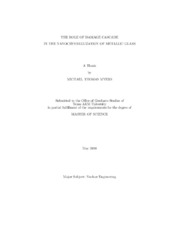| dc.description.abstract | The multi-scale modeling of ion-solid interactions presented can lead to a fundamentally new approach for understanding temperature evolution and damage formation. A coupling of the Monte Carlo code, SRIM, to a C FEM heat transfer code was performed, enabling a link between the damage cascade event to the subsequent heat transfer. Modeling results indicate that for 1 MeV Ni ion irradiation in Ni52.5Nb10Zr15Ti15Pt7.5, the heat transfer rate is too large for direct crystallization. Although the damage cascade induces a peak temperature of 5300 K, within 6 picoseconds the temperature is below the glass transition temperature. This result implies that there is a cooling rate of 10^14 K/s, which is much greater than the critical cooling rate for this material. Ion irradiation was performed to compare modeling with experiment. No evidence of direct crystallization is observed under TEM. Nanocrystals are formed as a consequence of series of multistage phase transitions. This provides evidence that the energy dissipation occurs too quickly for direct crystallization, as crystals are found in regions having undergone substantial compositional changes. A host of conventional electron microscopy methods were employed to characterize the structural changes induced by 1 MeV Ni ion irradiation in Ni52.5Nb10Zr15Ti15Pt7.5 and identify the phases that form, Ni3Nb, Ni3Ti and Ni3Zr. Scanning TEM analysis revealed Pt segregation near crystal regions due to irradiation. Due to a lack of Pt crystal phases observed and high concentrations of Pt in crystal regions it is postulated that Pt is substituting for Ni to form (Ni,Pt)3Nb and (Ni,Pt)3Ti. | en |


